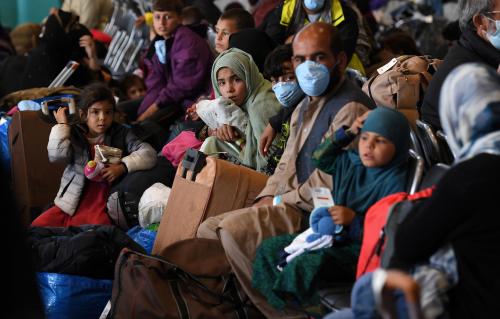The country is deeply divided. It is divided economically, but also politically and culturally. As these divisions widen, I’m convinced it’s time to revive a commitment to national service—and to make that commitment universal. “Universal” could mean mandatory, but more realistically, it should mean the creation of a strong expectation that every U.S. resident give one year of service—either military or civilian—and be provided with a structured opportunity to do so.
Most of us spent last week eating turkey and giving thanks for family and friends, or perhaps for our own health and prosperity. But how many of us asked what we owe our country and what we might do to improve it? In his 1961 inaugural address, John F. Kennedy famously said, “ask not what your country can do for you, ask what you can do for your country.” This led to the creation of the Peace Corps and, soon after, to its domestic equivalent VISTA (Volunteers in Service to America), which was later incorporated into the AmeriCorps network. President Clinton expanded on the idea by establishing the Corporation for National and Community Service (CNCS), an agency overseeing AmeriCorps and other volunteer services. Though the Trump administration has proposed eliminating CNCS, it remains popular among Republicans, Democrats, and voters of all stripes.
In the past, Republicans joined the parade of support for national service. In 1990, William F. Buckley called for a government-funded system of national service in “Gratitude: Reflections on What We Owe to Our Country.” The idea received support from both Presidents Bush, from Senators John McCain and Orrin Hatch, and from Governors John Kasich and Mitt Romney. There are many reasons why national service appeals to conservatives. It can be seen as an obligation or responsibility of citizenship, as well as an important part of the social contract. It relies not on government agencies to deliver services, but primarily on states, communities and the nonprofit sector. It requires only modest federal funding, but generates substantial funds from the philanthropic sector.
Democrats like national service for those reasons, too, but also because it provides young people with valuable experience and a chance to go to college. In addition, volunteers are working to solve environmental and social problems that government has sometimes neglected for lack of funding.
This broad support makes it unlikely that the Trump administration will succeed in eliminating CNCS, but the program has faced budgetary challenges from the start. The number of people applying to serve greatly exceeds the number of opportunities the agency can provide. At the same time, many nonprofit and local community groups are very dependent on national service program volunteers. In short, the demand for volunteers and the supply of people who want to volunteer both exceed the current capacity of government to bring the two together. A data-driven platform and some additional resources might solve the problem.
How does it work now? Anyone who is a U.S. citizen or legal permanent resident age 17 or older can apply for AmeriCorps. Volunteers typically serve for a year and receive a modest living allowance, priority hiring at about 450 companies, and the equivalent of a Pell grant to go to college if they complete a year of service. Most of the funding is channeled through state commissions and used for a variety of projects in education, health care, the environment, housing, disaster relief and helping the poor. It has provided volunteers for Teach for America, Youth Build, the Boys and Girls Clubs, the Red Cross, and many other well-known organizations.
Is there an economic case for national service? According to Clive Belfield, it easily passes a benefit-cost test. The taxpayer costs for youth alone are about $1.1 billion per year. Estimating the benefits is tricky. They can include both the value of the services or the output provided, plus the gains in experience, education, and lower social costs for the volunteers. Belfield’s study determines that a conservative estimate of taxpayer benefits suggests they exceed the costs by a ratio of more than two to one.
I do not think that expanding national service should be the only way to help young people bridge the gap between school and college or career, but it could play a role not only in helping young people afford more education or training, but—even more importantly—bringing a divided nation together. The journalist Roger Cohen, for example, recommends a “vastly expanded, even mandatory, national service program that might at once throw Americans of every creed and culture together for a year or two at an impressionable age, fire up civic engagement and even revive the American dream…American fracture is advancing by the day because Americans are no longer obliged to look one another in the eye and find solutions.”
General Stanley McChrystal, another advocate for national service, notes that the idea is timelier than ever as young people want to serve, local community organizations need the help, and the online platforms to run the programs efficiently now exists. In an essay for Cato Unbound, Zach Maurin notes that we are all lucky to live in America and suggests that the way to pay back our debt to those who built the country, and also strengthen it for the future, is through a year of national service. It’s the way we pay our dues for being Americans. It’s the way we strengthen civil society.
Many of today’s young people are floundering. They are uncertain about what they want to do with their lives. They need a structured opportunity that will allow them to feel needed and capable. Hugh Price, former head of the Urban League, sees great merit in using a military model to turn around the lives of less advantaged kids. He points to the success of the National Guard’s Youth Challenge program. Evaluations of AmeriCorps suggest that it instills the desire for continuous service and civic engagement.
Although young people should be the primary target of national service, there is no reason why retired Americans, veterans trying to reintegrate into civilian life, or anyone looking to do more for their community should not be provided the opportunity to do so. Elites and what Richard Reeves calls “dream hoarders” and their children should not be exempt.
Changing the culture to make national service the norm rather than the exception will be hard. But if employers and colleges give preference to those who have served, if the media highlights their accomplishments, and if peer groups and celebrities are on board, it can be done. We need not just a “program” to organize and fund the costs, but also a change in social norms that redefines citizenship as more than simply voting and obeying the law. And we need people to work with, and get to know, those from different backgrounds than their own.
Of course, there will be challenges. There will be some boondoggles. There will be some young people facing too many barriers to serve. There will be issues of coordination and management. And there will be substantial costs. But if we want to simultaneously make us stronger together and make America great again, it’s worth a try.










Commentary
It’s time to make national service a universal commitment
November 30, 2017